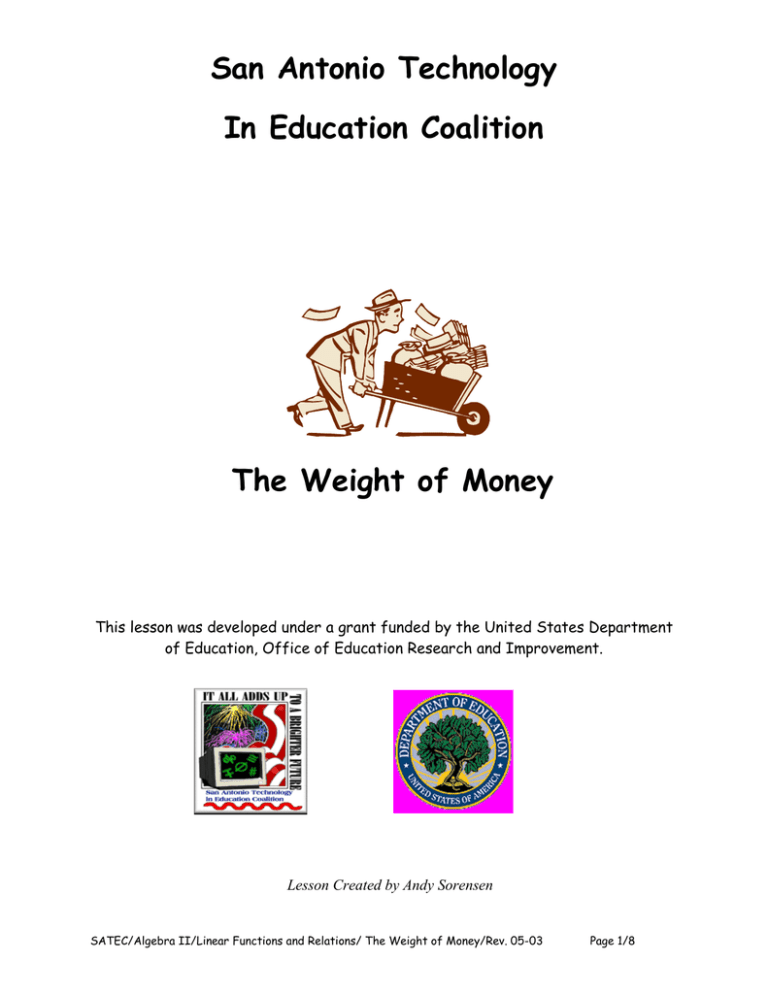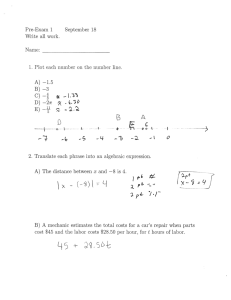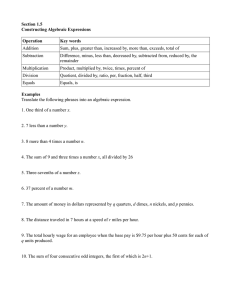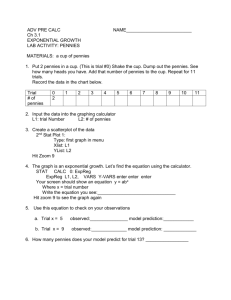San Antonio Technology In Education Coalition The Weight of Money
advertisement

San Antonio Technology In Education Coalition The Weight of Money This lesson was developed under a grant funded by the United States Department of Education, Office of Education Research and Improvement. Lesson Created by Andy Sorensen SATEC/Algebra II/Linear Functions and Relations/ The Weight of Money/Rev. 05-03 Page 1/8 The Weight of Money Introduction – About the Mathematics A. Student Performance Objectives – TEKS/EOC Correlation (b) Foundations for Functions. (1) The student uses properties and attributes of functions and applies functions to problem situations. (A) For a variety of situations, the student identifies the mathematical domains and ranges and determines reasonable domain and range values for given situations. (B) In solving problems, the student collects data and records results, organizes the data, makes scatterplots, fits the curves to the appropriate parent function, interprets the results, and proceeds to model, predict, and make decisions and critical judgments. (2) The student understands the importance of the skills required to manipulate symbols in order to solve problems and uses the necessary algebraic skills required to simplify algebraic expressions and solve equations and inequalities in problem situations. (C) The student connects the function notation of y = and f(x) =. (c) Algebra and geometry (1) The student connects algebraic and geometric representations of functions. (A) The student identifies and sketches graphs of parent functions, including linear (y = x), quadratic (y = x2), square root (y = x), inverse (y = 1/x), exponential (y = ax), and logarithmic (y = logax) functions. (B) The student extends parent functions with parameters such as m in y = mx and describes parameter changes on the graph of parent functions. SATEC/Algebra II/Linear Functions and Relations/ The Weight of Money/Rev. 05-03 Page 2/8 B. Critical Mathematics Explored In This Activity The continuation of this lesson will provide the physical relationship of the yintercept and the initial weight in the cup. Concepts studied during Part I and II will re-enforce all the relationship of the parameter changes and the role of each parameter with respect to the graph. C. How Students Will Encounter the Concepts The investigation will be used to determine the weight exerted by pennies in part II. This activity will actually use a probe to collect the data. Based on the data collected, students will be asked to make predictions about the number of coins needed to produce different weight. The investigation is a good opportunity to review the ideas of a variable, evaluating expressions, graphing, and solving simple equations. This latter occurs when students are asked to predict in reverse, i. e. if the weight exerted by coins is some value, how many coins are needed to exert that force. Students should already have learned the word axis in a previous course, but it would not hurt to review graph construction on an individual basis as the students are doing the activity. In Part III the students will notice that the rate of change remains constant in the relationship but the weight of the cup after 5 pennies has changed because of the two quarters added at the beginning of the problem. This will provide the opportunity to discuss how that will change the equation in the relationship and how the graph will be affected. D. Connection to Future Concepts As we are working through the algebra course we want the student to develop the concept that the world around them can be represented using mathematics. So emphasize the idea of a mathematics being applied as models to represent realworld situations. We want sentences like y=2x+3 to have meaning to the students in a concrete way. There is certainly a place for study of the concepts of graphing, linear equations, etc. in the abstract, but the majority of your students are not going to be pure mathematicians. For algebra to have use to the majority, we must make use of its power to model relevant situations which is the purpose of this introductory lesson. Please continue to use the vocabulary word model throughout the course. SATEC/Algebra II/Linear Functions and Relations/ The Weight of Money/Rev. 05-03 Page 3/8 E. Set Up Materials Needed For each group (2-3 students) • • • 1 Cup (See model to the right) String (used to create a handle for the cup to hang from the bridge and from the Force Probe). Coins (about 20 quarters & 200 pennies, 100 nickels or washers that are similar in weight to quarters, nickels and pennies) Cup Model Technology • Logger Pro; Force Sensor Probes In preparation for the activity, make sure that the Graphical Analysis and Logger Pro Program is installed on each student computer. Shortcuts for these programs should be created on the computer desktops to enable students to follow lesson directions. In order to carry out this lesson, students will need to access the Force Sensors Folder through which they will click on Dual Range Force, to in turn open a file called Weight of Money. Make sure that you put of copy of the file Weight of Money in the Dual Range Force Folder. When using the Force probe, be sure that the cup has the weight distributed evenly on the cup. Do not use paper clips to attach onto the cup unless you do it at the very top of the string, since the weight will be distributed unevenly. This will considerably alter the data. Also, it is important that you emphasize the importance of waiting for the data to "settledown" in the probe by allowing time for the reading to stabilize. F. Answers and Notes for the Student Activity. Student answers will vary based on difference in conducting the experiment. Hence, answers provided are simply a guide but should be rather consistent with these. SATEC/Algebra II/Linear Functions and Relations/ The Weight of Money/Rev. 05-03 Page 4/8 1. The rate of change is the same since you are increasing the weight each time by 0.025 per penny. What has changed is the y-intercept since the y-intercept represents the weight of the two quarters added to the cup initially. 2. The aswers will be very similar except that it will increase by the weight of the two quarters. 3. Answers will vary. The fist equation should have the same slope when compared to the equation in part II. Equation b should have different slope and yintercept. (a) w(c) = 0.025 C + ____ (b) w(c) = 4. The difference is that the second equation has a “b” value at the end (yintercept) This represents the weight of the two quarters. 5. The second graph should be identical to the first one with the exception of the y-intercept. 6. The equation would have the same rate of change but a different y-intercept. 7. The effect of the quarters in the experiment are reflected in the y-intercept of the equation. The y-intercept represents the initial amount of the cup if there were no pennies in the cup. 8. Answers will vary. It is recommended that you create a rubric to grade this question. SATEC/Algebra II/Linear Functions and Relations/ The Weight of Money/Rev. 05-03 Page 5/8 Name:____________________________Date:____________Period:_______ In this activity you will investigate how the graph and equation representing the weight of the coins changes as an initial weight is added, as well as making an interpretation of what each change represents in the equation. You will need to recall data and information from Part I and II completed on the Survey unit. • • • Open the file called Weight of Money. Follow the instruction in the text box to collect your data. Complete the table provided below. Part III. Changing the initial weight in the problem. As you recall, in Part I and II you observed how the weight changed as you increased the number of coins in the cup. If you remember, you had no coins in the cup at the beginning of the experiment. Therefore, your initial weight should have been zero (it is possible yours was something very close to zero if not zero!). Repeat the experiment from Part II but place two quarters in the cup before you add the pennies to the cup. • • • • • Click the Zero button. Add the two quarters, and the five pennies. Wait for the weight to stabilize and click Keep to record the weight of 5 pennies. Continue adding 5 pennies and record the weight each time. Repeat this procedure until you have a total of 40 pennies in the cup. Complete the table with two quarters at the beginning: Number of pennies 5 Weight SATEC/Algebra I/Linear Functions and Relations/Weight of Money/Rev. 07-01 Page 6/8 1. Determine the Rate of Change and compare it to the Rate of Change in part II. Explain your findings.____________________________________ ___________________________________________________________ ___________________________________________________________ ___________________________________________________________ 2. Explain how the relationship between the weight and the number of pennies changed by adding the two quarters to the cup. How is this going to affect your answers in question 7b and 7c?____________________________________ ___________________________________________________________ ___________________________________________________________ 1. Open Graphical Analysis and copy the data you collected in Part II. Label this as Pennies for the dependent variable. 2. Add a third column and record the data you collected in Part III. Be sure to label this new column as PQ (Pennies and quarters) 3. On the graph window, double-click on the dependent variable and check both pennies and PQ on the Y-Axis Setup. 4. Click on Analyze and select Automatic Curve Fit, and select linear from the list of functions. Click OK. 5. Again, click on Analyze and select Automatic Curve Fit, but change to Data Set 2 on the “Perform Fit on…” arrow. 3. Write a function representing the weight of the cup depending on the number of pennies using the parameters you obtained from the data collection. (a) Function in Part II:___________ (b) Function in Part III:___________ 4. Explain what is different in the two functions and why. __________________________________________________________ __________________________________________________________ SATEC/Algebra I/Linear Functions and Relations/Weight of Money/Rev. 07-01 Page 7/8 5. How is the graph of the second function different from the first function? What part of the equation do you suppose caused that change? Justify your answer. _____________________________________________________ ___________________________________________________________ ___________________________________________________________ 6. What would be the new function if you were to place 6 quarters in the cup at the beginning instead of 2, and how would that affect the new graph?_______ ___________________________________________________________ ___________________________________________________________ ___________________________________________________________ ___________________________________________________________ 7. What effect does the weight of the quarters have on the equation and the graph? What does it represent mathematically? ______________________ ___________________________________________________________ ___________________________________________________________ ___________________________________________________________ __________________________________________________________ 8. In your own words, describe the behavior of a graph based on the parameters for the equation y = mx + b investigated in this experiment. Explain in detail the role of m and how it changes the graph as the number either increases and decreases, and what it represents in terms of this situation; similarly explain the role of b and what it represents for this situation. Be sure to explain why the equation changed from the first experiment from y=mx to y=mx + b. Use graphs as part of your explanation. SATEC/Algebra I/Linear Functions and Relations/Weight of Money/Rev. 07-01 Page 8/8








